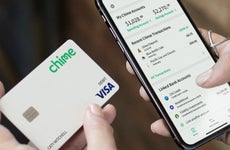Don’t overlook these money management tools in your banking app

The Bankrate promise
At Bankrate we strive to help you make smarter financial decisions. While we adhere to strict , this post may contain references to products from our partners. Here's an explanation for .
You probably use your bank’s mobile app for everyday tasks such as checking your account balance, paying bills and transferring money between accounts. However, many bank apps also provide some additional, often-overlooked features that could help you stay on top of your personal finances.
Such features commonly include credit monitoring, fraud prevention, budgeting tools and money-saving offers. In fact, more than half (53 percent) of consumers used bank-provided credit monitoring services in 2023, while 62 percent had set up digital alerts to protect against fraud and scams, a Chase survey found.
The apps offered by America’s five largest banks all come highly rated by iPhone and Android users in the App Store and on Google Play. Here we’ll list some noteworthy app features, broken down by bank, that can help you manage your money and meet financial goals.
Chase
Chase’s mobile app offers monthly and annual spending reports as well as cash-back opportunities from select merchants. Customers can also take advantage of various in-app tools that tie in with their Chase bank accounts or credit cards:
-
Account alerts: Most banks allow customers to set up alerts through app notifications or text messages when certain account activity occurs. For instance, you can tell the app to alert you when:
- A username, password or mailing address is changed
- An account balance falls below a set threshold
- A check is returned due to insufficient funds
- An outgoing wire transfer amount exceeds a specified threshold
- Users are added to an account
- Short- and long-term money management tools: The Chase app’s “Wealth Plan” feature can help you keep track of your income and spending, as well as plan for life events. Your goals dashboard is automatically updated when you’ve saved set percentages of your target amount. It also provides “what if” scenarios regarding your goals, such as how much you’d be able to spend each month when retiring at different ages.
- Credit monitoring: You can use Chase’s “Credit Journey” tool to see your credit score and credit history, as well as your credit card balances and limits — all on a single dashboard. You can also opt in for identity monitoring, which includes dark web surveillance, data breach monitoring, and tracking of changes linked to your Social Security number.
Bank of America
Like apps from many other banks, Bank of America’s app provides access to customers’ FICO scores, month-to-month score tracking, and information about key factors that impact this score. Users also have access to additional money-saving and self-help features in the app:
- Cash-back opportunities: Through the BankAmeriDeals feature, you can access cash-back offers from a list of merchants, and qualifying purchases provide a percentage back to your account. Other types of offers provide a set discount or dollar amount off a purchase. Common deals include those for food, entertainment, retail and travel.
- Goals tool: As a Bank of America customer, you can use the app to set and track savings goals, whether you wish to buy a house, pay off a loan or save for retirement. The app provides checklists and articles based on what you’re saving for, and it displays celebratory messages as you reach savings milestones.
- Virtual financial assistant: Bank of America’s virtual financial assistant, named Erica, enables customers to type or speak their questions or requests while using the app. The chatbot can help with matters such as relaying your account balance, helping you find a nearby ATM, or walking you through transferring money between accounts. It can also help connect you to a bank representative for assistance.
Wells Fargo
Wells Fargo customers can use the app to manage alerts, set up an appointment with a banker, and track WellsTrade investments. The app also provides various financial tools and resources:
-
My Money Map: This tool is designed to help you keep track of your spending and saving.
- Spending tracking: In this section, you can create a personalized budget and track your spending. Tables, bar graphs and pie charts are incorporated, such as a spending vs. budget bar graph that shows areas of overspending based on a monthly budget you input.
- Savings planning: This allows you to name your money goals and associate dollar amounts with them. You can set up automated transfers and keep track of your savings progress.
- Free FICO score: Customers have free access to their FICO score, as well as their credit report, credit monitoring alerts, and some personalized tips on how to improve one’s score. The score is displayed on a color-coded graphic, along with a line graph showing a month-to-month score history.
- Financial health hub: The app provides articles on saving for emergencies and retirement as well as managing spending, credit and debt. Each section includes links to corresponding money management tools on the app.
Citibank
Citibank’s mobile app comes highly rated, having been reviewed by more than 4 million iPhone and Android users, collectively. Customers can use the app to open new accounts, pay friends with Zelle and manage their money through additional features, such as:
- Mobile snapshot: Users who opt in for this feature can view high-level account information, including a bank and credit card account summary, without having to sign in to the app.
- Link external accounts: Customers can link external bank, credit card and investment accounts to provide a complete picture of all accounts in one place.
- Security features: If you’ve forgotten your debit card’s PIN or want to change it, you can reset it within the app.You can also use the app’s “Citi Quick Lock” feature to lock or unlock a debit card that’s lost or stolen.
U.S. Bank
In addition to providing cash-back deals, a spending tracker and a portal for saving for financial goals, U.S. Bank’s app offers various tools regarding personal finances and customer support:
- Financial Wellness Center: The U.S. Bank app features financial education content and tools on topics such as building up an emergency fund, buying your first home, saving for college and preparing for retirement.
- Spanish language voice assistant: While using the app, customers can talk into their smartphone in Spanish in order to transfer and send money, make payments, lock and unlock a card or track their credit score.
- Cobrowse feature: Anyone having trouble using the app (or the U.S. Bank website on a computer) can click a link to join a cobrowse session, during which a banker can see your screen and help you navigate the app.
Key features in a mobile bank app
Money management tools
These days, you can use your bank’s mobile app for much more than checking your balance, paying bills, depositing checks and transferring money between accounts. Many apps, from big and small banks alike, incorporate a host of tools to help you manage your personal finances. These include:
- Budgeting features such as worksheets
- Ability to set savings goals
- Graphs and charts to show spending and saving activity
- Automatic transfers from checking to savings
- Ability to view all accounts in one place (including external accounts)
- Credit score and credit monitoring
- Identity monitoring
- Cash-back offers from various merchants
- Chatbots to provide live assistance
Customer experience
Ideally, a bank’s mobile app should be quick and easy to use, with a user-friendly dashboard that shows high-level details and lets you access other features in just a tap or two. This includes viewing your account balance and recent transactions or transferring money between accounts.
“Customer experience is key for any mobile app,” says Justin Leto, CEO/president and co-founder of fintech small business lender Idea Financial. “Customers are looking for access to important account info as well as the ability to pay bills, send wires, transfer money and deposit mobile checks. A good app should provide these functions with one click.”
Security
With the growing prevalence of bank fraud and identity theft, it’s more important than ever to keep your financial information secure when downloading and using an app. In fact, using your bank’s mobile app is generally more secure than using your bank’s website on a computer, says Tracy Kitten, director of fraud and security at Javelin Strategy & Research. This is thanks to apps’ baked-in security and password protections, she says.
“Ultimately, the same types of security/safety features apply [with an app] as you would recommend for online banking,” Kitten says. She recommends taking these precautions:
- Choose a strong username and password when setting up access to the app after downloading it. Change your password at least every 90 days.
- Enable face recognition for signing on to the app, so you aren’t re-entering the username and password each time.
- Keep your mobile device password protected.
- Do not use the same password for your bank app that you use elsewhere, such as on social media sites.
- Use multifactor authentication when logging on. “You can typically pair mobile banking apps and online banking, so that you get a push notification via your mobile banking app when you try to log in to online banking to verify your identity,” Kitten says.
Bottom line
Your bank’s mobile app likely offers tools well beyond the basics of checking your balance and transferring money. It’s worth looking into what money management resources may be available in the app that could help make it easier and safer to budget and save your money.
Related Articles

9 bank accounts with built-in budgeting tools to help track your personal finances


